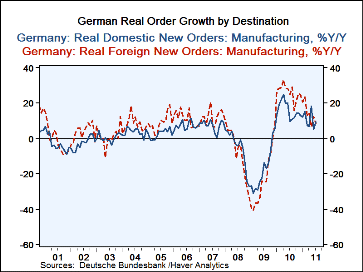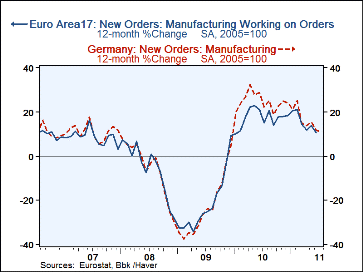 Global| Sep 06 2011
Global| Sep 06 2011German Orders Pull Back; Can The Zone Be Far Behind?
Summary
German orders fell by 2.8% after two months of rising and were weaker than had been expected in July. Year-over-year orders are up by 8.7% on roughly similar growth for domestic-sourced orders and foreign orders, but after that the [...]
 German orders fell by 2.8% after two months of rising and were weaker than had been expected in July.
Year-over-year orders are up by 8.7% on roughly similar growth for domestic-sourced orders and foreign
orders, but after that the similarity ceases. Domestic orders are up at a 12.5% annualized rate over
three-months and 5.1% rate over six months. Foreign orders are off at a sharp 6.7% pace over
three-months and off at a 2.2% pace over six months.
German orders fell by 2.8% after two months of rising and were weaker than had been expected in July.
Year-over-year orders are up by 8.7% on roughly similar growth for domestic-sourced orders and foreign
orders, but after that the similarity ceases. Domestic orders are up at a 12.5% annualized rate over
three-months and 5.1% rate over six months. Foreign orders are off at a sharp 6.7% pace over
three-months and off at a 2.2% pace over six months.
The pressure on the German economy and the severe sliding represented by the recent weakness in the Markit PMI gauges make the domestic orders figures seem less solid. While we look at Germany as the competitive leader in Europe the second chart shows that in fact German orders are simply a good image of what orders are doing in the Euro-Area as a whole. German orders did boom more early in the recovery but there is no denying that the profiles for German and overall euro-area orders are highly similar.
But even with the boom Germany has not been able to get orders back to pre-recession levels currently German
orders are 91% of their past cycle peak with domestic orders at 93% of their past cycle peak.

On the current quarter (just started with July data) both foreign and domestic orders are contracting compared to the average in the previous quarter.
Still by sector German sales are looking good, despite some more up-to-date PMI data to the contrary. Through July, anyway, the consumer durables sales in Germany are strong, up at a 35% annual rate over three months. Capital goods sales are up at a 25% annual rate. Intermediate goods are sales are rising at a 10.5% annual rate. Overall MFG sales are up at a 12.6% annual rate in the three-months ended in July.
One of the key questions for Germany is how recent the new round of weakness really is and when it will be reflected in the data that are the real economic barometers. Or is confidence in some sense just flaky and will it all just go away? Orders which are forward-looking are showing declines while sales that are ‘current diagnostics’ are still going gangbusters. On the other hand the even more timely PMI data show some severe slowdowns.
We are in a period of flux with plenty of danger ready to be seen. We can understand the risks to growth and partly for that reason confidence has been harmed. It is possible that real activity is hurt less than confidence readings make it seem. It is also true that perception tends to drive actions and actions affect and determine reality. It would be wrong to dismiss the threats we see and we should be careful not to sugar-coat the bad news which is real even if it mostly affecting forward-looking and confidence-like measures for now.
| German Orders and Sales By Sector and Origin | ||||||||
|---|---|---|---|---|---|---|---|---|
| Real and SA | % M/M | % SAAR | ||||||
| Jul 11 |
Jun 11 |
May 11 |
3Mo | 6Mo | 12Mo | YrAgo | QTR-2 Date |
|
| Total Orders | -2.8% | 1.8% | 1.5% | 1.7% | 1.0% | 8.7% | 17.7% | -6.6% |
| Foreign | -7.4% | 13.1% | -6.0% | -6.2% | -2.2% | 8.3% | 25.2% | -9.6% |
| Domestic | 3.6% | -10.1% | 10.7% | 12.5% | 5.1% | 9.3% | 9.8% | -2.3% |
| Real Sector Sales | ||||||||
| MFG/Mining | 4.2% | -0.1% | -0.9% | 13.1% | 10.3% | 10.9% | 10.3% | 25.0% |
| Consumer | -1.3% | 2.9% | -4.3% | -10.9% | 6.1% | 2.6% | 2.7% | -5.3% |
| Cons Durables | 12.2% | -4.0% | -0.6% | 31.5% | 25.4% | 12.5% | 11.7% | 67.4% |
| Cons Non-Durable | -3.5% | 4.0% | -4.9% | -16.9% | 2.9% | 0.9% | 1.2% | -14.5% |
| Captial Gds | 7.0% | -0.4% | -0.7% | 25.6% | 13.7% | 15.5% | 10.5% | 46.1% |
| Intermediate Gds | 2.9% | -0.5% | 0.2% | 10.5% | 8.2% | 10.8% | 14.5% | 16.6% |
| All MFG-Sales | 4.1% | -0.1% | -0.9% | 12.6% | 10.1% | 10.9% | 10.3% | 24.2% |
Robert Brusca
AuthorMore in Author Profile »Robert A. Brusca is Chief Economist of Fact and Opinion Economics, a consulting firm he founded in Manhattan. He has been an economist on Wall Street for over 25 years. He has visited central banking and large institutional clients in over 30 countries in his career as an economist. Mr. Brusca was a Divisional Research Chief at the Federal Reserve Bank of NY (Chief of the International Financial markets Division), a Fed Watcher at Irving Trust and Chief Economist at Nikko Securities International. He is widely quoted and appears in various media. Mr. Brusca holds an MA and Ph.D. in economics from Michigan State University and a BA in Economics from the University of Michigan. His research pursues his strong interests in non aligned policy economics as well as international economics. FAO Economics’ research targets investors to assist them in making better investment decisions in stocks, bonds and in a variety of international assets. The company does not manage money and has no conflicts in giving economic advice.






